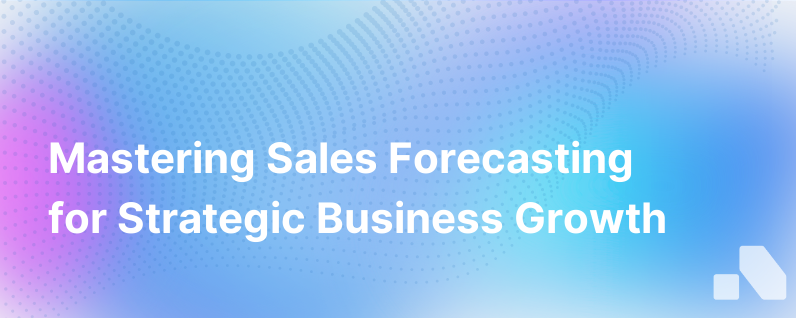
Sales forecasting stands as an indispensable component within the operational strategy of any business. It propels informed decision-making, aids in managing expectations both internal and external, and serves as a barometer for the health of a company’s sales pipeline. To ignore sales forecasting is to navigate the competitive market landscape without a compass or a map, leaving businesses vulnerable to sudden storms of market fluctuations and unseen cliffs of missed targets. Let us explore the multifaceted nature of sales forecasting and underscore its critical importance in achieving successful business outcomes.
The Multidimensional Utility of Sales Forecasting
Sales forecasting is not merely about predicting a number; it’s about understanding and anticipating the future of your business. It informs numerous functional areas, including but not limited to:
-
Financial Planning: A strong forecast allows you to anticipate revenue, manage cash flow effectively, and make investment decisions confidently. By projecting future sales, companies can ensure that they maintain sufficient liquidity for operations and capital investments, and avoid the pitfalls of fiscal shortfalls.
-
Inventory Management: With an accurate sales forecast, inventory levels can be optimized, ensuring that product availability aligns with demand. This prevents the costly consequences of stockouts or excessive inventory, with the latter leading to increased holding costs and potential waste, especially for perishable goods.
-
Resource Allocation: Labor and production resources can be allocated more efficiently when there is clarity on future sales volumes. This optimal allocation drives down costs and improves profit margins by matching resource expenditure with anticipated revenue.
-
Performance Management: Sales forecasting establishes benchmarks against which actual sales and team performance can be measured. It helps in setting realistic targets and adjusting sales strategies based on prevailing or anticipated market conditions.
-
Risks Mitigation: The inherent uncertainties of the market mean that risks are ever-present. Forecasting helps to identify potential headwinds or tailwinds affecting sales, allowing businesses to pivot strategies, brace for impact, or harness favorable winds effectively.
Building a Foundation for an Effective Sales Forecast
Crafting an effective sales forecast requires more than just historical data; it necessitates a comprehensive understanding of market conditions, pipeline health, and an array of external factors, including economic indicators, competition, and industry trends. At its core, an effective forecast is built on the following pillars:
-
Data-Driven Insights: Utilize CRM tools to collect and analyze historical sales data. Trends, seasonalities, and sales cycle length are some of the myriad datapoints that can provide a quantitative backbone for forecasts.
-
Sales Pipeline Analysis: Examine the stages and progression rates of deals within the sales pipeline. This helps in understanding the likelihood of conversions and timing, key inputs for any forecast.
-
Market Intelligence: Keep a pulse on the market. Use competitive intelligence, understanding of industry-specific cycles, economic indicators, and customer sentiment to refine your forecasts.
-
Methodological Approach: Whether it's a top-down or bottom-up approach, using a defined method helps in achieving consistency and allows for method refinement over time.
-
Collaborative Inputs: Sales forecasts should not exist in a silo. Collaboration with marketing, finance, customer success, and the sales team itself ensures a multi-faceted perspective is incorporated into the forecast.
The Consequences of Ignoring Sales Forecasting
Failing to prioritize sales forecasting can lead to a cascade of adverse effects:
-
Revenue Uncertainty: Lack of visibility into anticipated sales results in guesswork, which is the harbinger of unstable revenue streams and a shaky financial footing.
-
Missed Opportunities: Without an accurate sales forecast, it's challenging to capitalize on market opportunities. Companies might miss out on scaling production for peak demand seasons or capitalizing on emerging trends.
-
Over or Under Resourcing: Misalignment of resources leads to inefficiencies. Overstaffing can drain finances, whereas understaffing can lead to missed sales and poor customer experiences.
-
Inventory Mishaps: Erroneous demand predictions result in inventory discrepancies, leading to wasted resources or lost sales.
-
The Bottom Line: Ultimately, the profitability of the business is at stake. Accurate forecasting informs sound strategy, which in turn drives revenue and profitability.
Leveraging Advanced Tools for Sales Forecasting
The environment for modern sales forecasting has been revolutionized by the advent of advanced CRM platforms, predictive analytics, and AI-driven insights. Tools like these give businesses unprecedented clairvoyance into future performance.
Platforms such as Aomni can transform the sales forecasting process from an educated guess into a precise science. They harness vast amounts of sales data, employ sophisticated algorithms, and deliver increasingly accurate predictions as more data become available. These tools also decrease the time and resources spent on forecasting, freeing up sales teams to focus on what they do best—selling.
Conclusion
Sales forecasting is the lighthouse guiding businesses through the currents and fluctuations of the market. It stands as the underpinning for financial stability, resource optimization, and strategic planning. In an era where data is king and predictive analytics reign, tools such as Aomni are making sales forecasting more precise and insightful, allowing businesses to chart a course to continued growth and success.
In conclusion, sales forecasting isn’t just a part of business—it is the psychic pulse, the prognostic heart that allows organizations to envision the future and prepare effectively for it. It is an essential exercise in prudence, a testament to the acumen of business leaders, and a practice that, when executed with precision, can herald sustained commercial triumph.